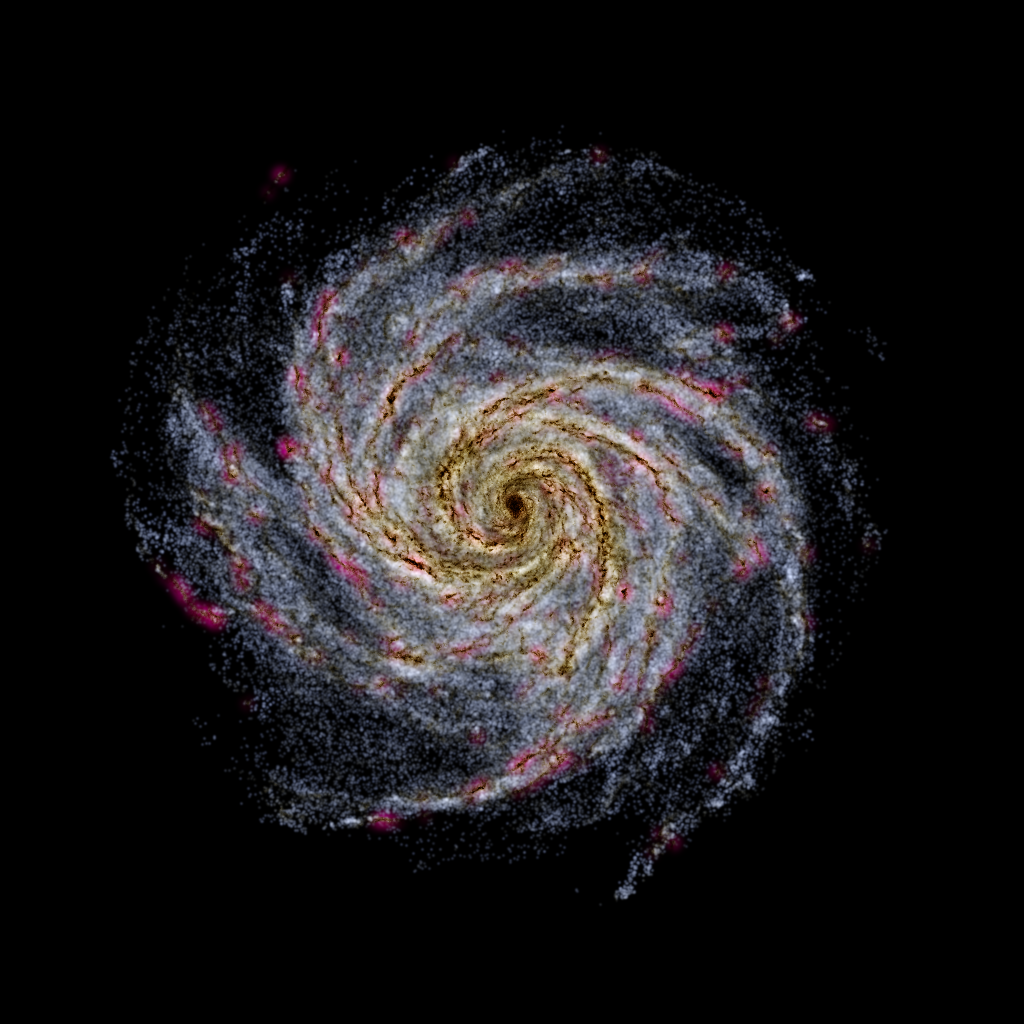Generating a multi-components galaxy¶
The script ic_makeGalaxy allows to create a multi-component galaxy model at equilibrium, combining
a gas disk (Miyamoto-Nagai), a stellar disk (Exponential disk) a bulge (Plummer model) and a dark halo (generic 2-slope model).
The equilibrium is obtained by solving the Jean equation in both spherical and cylindrical coordinates.
By default the script create a Milky-Way like galaxy, assuming a set of parameters. The command:
ic_makeGalaxy -o MW_galaxy.hdf5
will create the MW_galaxy.hdf5 file containing all the particles.
The script can however take the parameters from a yaml file:
ic_makeGalaxy -p params.yml
where the params.hdf5 file contains for example the following parameters:
# using default parameters in tmp_parameter_file.yml
OutputUnits:
UnitLength_in_cm: 3.085e21 # 1 kpc in centimeters
UnitMass_in_g: 1.98848e43 # 10^10 M_sun in grams
UnitVelocity_in_cm_per_s: 1e5 # 1 km/s in centimeters per second
Galaxy:
m_ref: 200000 # reference mass of particles [solar mass]
nf: 1 # particle count multiplicative factor (used to reduce noise)
hydro: 1 # if set to 0, turn gas to collisionless particles
ftype: "swift" # output format (swift, gh5, gadget)
outputfilename: "galaxy.hdf5" # output file name
irand: 0 # random seed
boxsize: 1500 # boxsize [kpc]
# Parameters for gas component
Gas:
fm: 1 # particle mass to ref. mass ratio (set to 0 disable the component)
mass: 0.5e10 # component mass [solar mass]
Hr: 4.0 # radial scale [kpc]
Hz: 0.3 # vertical scale [kpc]
rmax_to_Hr_ratio: 10 # rmax to Hr ratio
zmax_to_Hz_ratio: 3 # zmax to Hz ratio
sigmavel: 10 # velocity dispersion [km/s] (if hydro=0)
T: 100 # temperature [K] (if hydro=1)
# Parameters for disk component
Disk:
fm: 1 # particle mass to ref. mass ratio (set to 0 disable the component)
mass: 2e10 # component mass [solar mass]
Hr: 2.0 # radial scale [kpc]
Hz: 0.3 # vertical scale [kpc]
fr: 10 # grid rmax to Hr ratio
fz: 10 # grid rmax to Hr ratio
toomre: 2 # Toomre stability criterion
# Parameters for bulge component
Bulge:
fm: 1 # particle mass to ref. mass ratio (set to 0 disable the component)
mass: 0.4e10 # component mass [solar mass]
Hr: 1.0 # radial scale [kpc]
fr: 5.0 # grid rmax to Hr ratio
# Parameters for dark halo component
Halo:
fm: 5 # particle mass to ref. mass ratio (set to 0 disable the component)
mass: 115e10 # component mass [solar mass]
c: 10 # concentration parameter
alpha: 1 # inner slope
beta: 3 # outer slope
Rcut: None # cutting radius [kpc]
power_cut: 3 # power of the cut if Rcut is defined
fr: 1.0 # rmax to r200 ratio
dR: 0.25 # grid resolution [kpc]
Plotting the corresponding rotation curve¶
To check the rotation curve corresponding to the model generated, pNbody offers the following command:
plotCylindricalProfile -y vcirc --xmax 50 --rmax 50 --nr 64 --nr 64 --eps 0.1 --forceComovingIntegrationOff MW_galaxy.hdf5
More examples¶
Additional examples of dwarf galaxies or galaxies with cusp or core may be found in the pNbody/examples/ic/ic_makeGalaxy directory.
Scripts¶
ic_makeGalaxy¶
usage: ic_makeGalaxy [-h] [-p PARAMETER_FILE] [-o OUTPUTFILENAME] [--debug]
[--print-parameters] [--HubbleParameter HUBBLEPARAMETER]
Generates a mulit-component galaxy model
options:
-h, --help show this help message and exit
-p PARAMETER_FILE, --parameter-file PARAMETER_FILE
Name of the parameter file
-o OUTPUTFILENAME Name of the output file
--debug debug mode: save intermediate files
--print-parameters print parameters and quit
--HubbleParameter HUBBLEPARAMETER
Hubble parameter
The model is made out of four components:
a gas disk (Miyamoto-Nagai)
a stellar disk (Exponential disk)
a bulge (Plummer model)
a dark halo (generic two slope model)
All components can be fine tuned using parameters provided by a parameter file (see below).
Examples:
--------
ic_makeGalaxy
ic_makeGalaxy -p params.yml
ic_makeGalaxy -p params.yml -o galaxy.hdf5
ic_makeGalaxy --print-parameters
where the file params.yml contains the following parameters:
'''
OutputUnits:
UnitLength_in_cm: 3.085e21 # 1 kpc in centimeters
UnitMass_in_g: 1.98848e43 # 10^10 M_sun in grams
UnitVelocity_in_cm_per_s: 1e5 # 1 km/s in centimeters per second
Galaxy:
m_ref: 200000 # reference mass of particles [solar mass]
nf: 1 # particle count multiplicative factor (used to reduce noise)
hydro: 1 # if set to 0, turn gas to collisionless particles
ftype: "swift" # output format (swift, gh5, gadget)
outputfilename: "galaxy.hdf5" # output file name
irand: 0 # random seed
boxsize: 1500 # boxsize [kpc]
# Parameters for gas component
Gas:
fm: 1 # particle mass to ref. mass ratio (set to 0 disable the component)
mass: 0.5e10 # component mass [solar mass]
Hr: 4.0 # radial scale [kpc]
Hz: 0.3 # vertical scale [kpc]
rmax_to_Hr_ratio: 10 # rmax to Hr ratio
zmax_to_Hz_ratio: 3 # zmax to Hz ratio
sigmavel: 10 # velocity dispersion [km/s] (if hydro=0)
T: 100 # temperature [K] (if hydro=1)
# Parameters for disk component
Disk:
fm: 1 # particle mass to ref. mass ratio (set to 0 disable the component)
mass: 2e10 # component mass [solar mass]
Hr: 2.0 # radial scale [kpc]
Hz: 0.3 # vertical scale [kpc]
fr: 10 # grid rmax to Hr ratio
fz: 10 # grid rmax to Hr ratio
toomre: 2 # Toomre stability criterion
# Parameters for bulge component
Bulge:
fm: 1 # particle mass to ref. mass ratio (set to 0 disable the component)
mass: 0.4e10 # component mass [solar mass]
Hr: 1.0 # radial scale [kpc]
fr: 5.0 # grid rmax to Hr ratio
# Parameters for dark halo component
Halo:
fm: 5 # particle mass to ref. mass ratio (set to 0 disable the component)
mass: 115e10 # component mass [solar mass]
c: 10 # concentration parameter
alpha: 1 # inner slope
beta: 3 # outer slope
Rcut: None # cutting radius [kpc]
power_cut: 3 # power of the cut if Rcut is defined
fr: 1.0 # rmax to r200 ratio
dR: 0.25 # grid resolution [kpc]
'''
